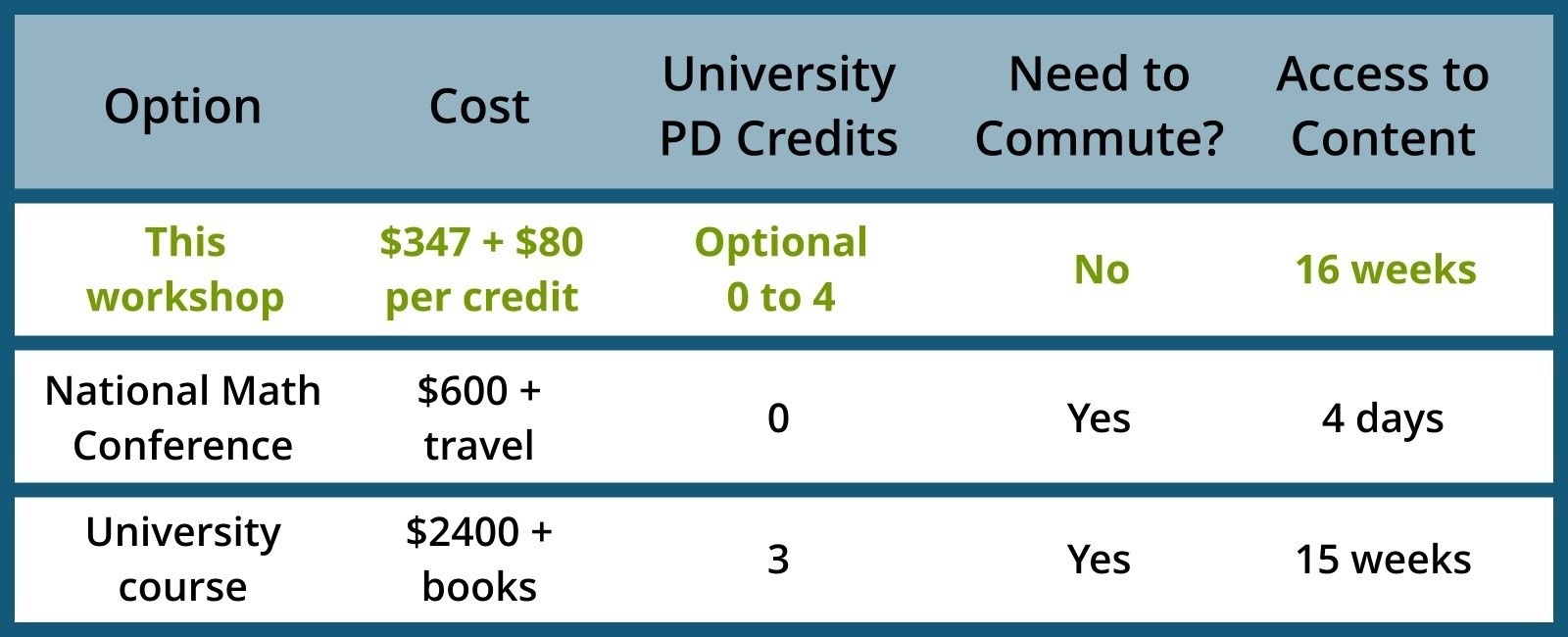What is in the Workshop?
Module 1: What Does It Mean to Think Additively about Subtraction?
What is in the Workshop?
Module 1: What Does It Mean to Think Additively about Subtraction?
What Will I Learn?
- What "Math is Figure-Out-Able" means, what is real math, and what it means to mathematize
- What it means to be a mentor to young mathematicians
- Why it is important to develop reasoning, not just get answers
- Why the traditional subtraction algorithms are not the goal
- Steps to take action in your classroom
Why Is This Important?
This is the why, the background, the setting that sets the stage for the rest of the workshop, so that you can implement lessons and strategies knowing how it all fits together.
___________________________________________________
Module 2: Building Strategies
What Will I Learn?
- The two interpretations of subtraction and why students need to deeply understand both of them
- A spatial model for representing student thinking
- Problem Strings to build strategies with students
- Steps to take action in your classroom
Why Is This Important?
Students need to deeply understand the two interpretations of subtraction so they can reason about subtraction across varying contexts. They also need both interpretations in order to decontextualize and develop intuition for efficient subtraction strategies. Owning numerical relationships leads to solving problems in efficient, clever, and creative ways.
___________________________________________________
Module 3: The Connection Between Addition and Subtraction
What Will I Learn?
- Instructional routines to build number sense and numerical relationships
- A Problem String to cinch the strategies related to the two interpretations of subtraction
- How the big mathematical idea of equivalence contributes to efficient problem solving
- Steps to take action in your classroom
Why Is This Important?
It is not enough for students to solve problems if they are not also growing in mental sophistication. As students build numerical relationships, they draw on them to solve problems in clever and sophisticated ways. Students look at the problem and let the numbers dictate the strategy based on the inherent relationships.
___________________________________________________
Module 4: Getting More Sophisticated
What Will I Learn?
- A Problem String to introduce the most sophisticated subtraction strategy
- Strategies for finding partners of 100 and why this relationship is so important to subtraction work
- How context and decontextualizing contribute to sense making and flexibility
- Steps to take action in your classroom
Why Is This Important?
Students need to own sophisticated strategies so they can solve subtraction problems within other work they are doing without getting bogged down. Students frequently subtract, especially from decade and century numbers, when reasoning about multiplication and division problems. Building sophisticated subtraction strategies helps students become more flexible and fluid in multiplicative reasoning.
___________________________________________________
Module 5: Top 3 Types of Tasks for Student Success
What Will I Learn?
- What Rich Tasks are and how they can be used to develop big ideas
- Problem Strings to introduce and solidify strategies, models, and big ideas
- How Problem Strings and Problem Talks work together and how to sequence lessons to maximize learning
- Steps to take action in your classroom
Why Is This Important?
This is the how-to-do-it module. We study different types of instructional tasks and routines, discerning their role in constructing mathematical ideas in learners’ brains. Our goal is to always be moving the math and the mathematician forward. Understanding how to use and leverage different instructional tasks allows you to ensure success for all your students all of the time.
___________________________________________________
Module 6: High-leverage Teacher Moves that Help You Help Your Students
What Will I Learn?
- High leverage teacher moves to encourage student sense making
- Teacher moves that support equity and access
- Teacher moves to differentiate—to support and challenge all learners
- How to support meaningful discourse to facilitate learning
- Steps to take action in your classroom
Why Is This Important?
Teaching in a way that allows all students to learn and grow is not a trivial task. There are purposeful moves teachers can make that promote class discussion and mathematical dialogue, position all students as sense makers, and build a culture of curiosity and empowerment.
In this module, you’ll learn the high level teacher moves that make the learning happen like a pro.
___________________________________________________
Module 7: Developing Subtraction in Younger Learners and Extending Subtraction in Higher Math
What Will I Learn?
- How to help beginners reason about the relationship between addition and subtraction
- Beginning subtraction strategies for young learners
- How to help students think and reason through integer subtraction
- How to help students think and reason through algebra applications without using an algorithm/formula
- Steps to take action in your classroom
Why Is This Important?
This workshop starts with the assumption that some subtraction work has already happened. If you work with students who do not own the single-digit subtraction facts, this module gives you tools to help support their mathematical development.
Subtraction doesn’t stop in 5th grade, but older students often won’t engage in a review of subtraction, no matter how much they need it. Teachers in middle and high school need an entry point to build subtraction in the content they teach. Here we identify places subtraction naturally comes up in middle and high school content and how to build subtraction while addressing grade level content.
___________________________________________________
Live Q&A Sessions With Pam
During the workshop you will have the opportunity to submit questions to Pam for her to answer during two live Q&A sessions. The sessions will be recorded and you will have access to them.





